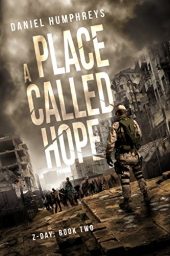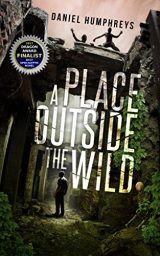THROWBACK SF THURSDAY: A Place Called Hope by Daniel Humphreys
Thursday , 23, November 2017 Book Review 4 Comments Happy Thanksgiving. If you are looking for things to be thankful for, here are a couple:
Happy Thanksgiving. If you are looking for things to be thankful for, here are a couple:
- Good books
- No zombie apocalypse (yet)
If you haven’t read Daniel Humphreys’ A Place Outside the Wild, go read my review of that book. I can’t really talk about its sequel, A Place Called Hope, without spoiling major surprises in the first book. And A Place Outside the Wild may be the best zombie apocalypse book I have ever read. Humphreys incorporates the familiar canon and builds on it, both in service of the meticulously plotted story. Another highlight is the attention to detail regarding everything from guns to farming—an attention to detail in service of building narrative tension.
My only quibble with both books is that the dialogue—especially the manly banter—is a bit clunky. (The actual presence of manly banter, on the other hand, is nice to see.)
A Place Called Hope is every bit as good as A Place Outside the Wild. It may not be able to deliver the same shocks as its predecessor, but Humphreys continues to surprise us, and there are some awesome action set pieces.
Major SPOILERS for A Place Outside the Wild, and very minor SPOILERS for A Place Called Hope below the fold.
Most of A Place Outside the Wild takes place in a single post-apocalyptic settlement. It ends with the residents naming it “Hope.” Hence the name for the sequel. But it is a bit of a misnomer—very little of A Place Called Hope actually takes place in Hope. Miles, the main character from the first book, and most of the rest of the residents of Hope only make cameo appearances. This is very much the story of Pete and Charlie and the military (and one other).
At the end of A Place Outside the Wild, Miles’ uncle Pete, a retired Marine, accepts a new commission, two missing legs notwithstanding (I’m reading Myke Cole’s Siege Line now, so that’s a couple books in a row featuring amputees in combat roles). Charlie is a settler known for his ability in the wild as a scavenger and for being immune to the zombie “virus.” After being exposed to the 2.0 version, he has regained the full ability to speak. Pete pulls him along for their mission.
 One of the big reveals from A Place Outside the Wild is that the military (mainly the Navy) has survived. The military has a big problem. After eight years, it is getting very hard to keep helicopters in the air. They have a plan to address the problem that involves a mission to recover airships in California.
One of the big reveals from A Place Outside the Wild is that the military (mainly the Navy) has survived. The military has a big problem. After eight years, it is getting very hard to keep helicopters in the air. They have a plan to address the problem that involves a mission to recover airships in California.
The really big reveal from A Place Outside the Wild was that the nanite-driven zombies are changing. A Place Outside Hope shows that process is still ongoing. Things are going to get really ugly.
Humphreys Z-Day books are a counterweight to more cynical works like The Walking Dead. The humans in A Place Called Hope are almost always the good guys. If you are going to set a work eight years after the zombie apocalypse, it makes sense that “[r]aider crews [are] the exception rather than the rule” because “groups like that [are] more likely to burn out than thrive.” (I think that a stable settlers/nomads dynamic could develop, but nomad raiders can’t exist without good guy settlers.) The military are both the good guys and survived at much higher rates than civilians (or at least the Navy did). Both of these are not just plausible but probable.
We do get to see some raiders through the eyes of a new POV character, Sandy. Sandy is a microbiologist, and his chapters revolve around him joining a settlement a couple hundred days after Z-Day. The window into the months directly after Z-Day are nice since the first book jumped straight to eight years after.
With the increased role for the military, A Place Called Hope is almost a military thriller/SF. It has a lot in common with the Myke Cole book I’m reading now. It also reminds me a lot of Brad Thor’s books, especially Code of Conduct. Thor could have written the line, “[I]n one fell swoop, the scientists had rendered the Holocaust and Holodomor mere footnotes.” (Like Thor, Humphreys wears his politics on his sleeve, but he’s right to compare the two, and the sentence has a nice ring to it.)
Thor would also appreciate Humphreys’ attention to military detail. There is a much warranted knock on World War Z. I very briefly made the same critique in my review. Humphreys says it better than I ever could:
“[S]he’d never forgotten the annoyance and derision she’d felt when she’d read the author’s description of a battle in which the army of zombies had marched forward, unaffected by modern ordnance. The venerable .50 BMG was officially an anti-material round, for God’s sake.”
If you want to see what modern military ordnance would do to zombies, A Place Called Hope is your chance.
I can’t wait for book 3.
Disclosure: Humphreys sent me a review copy.
H.P. is an academic, attorney, and “author” (well, blogger) who will read and write about anything interesting he finds in the used bookstore wherever he happens to be for the moment. He can be found on Twitter @tuesdayreviews and at Every Day Should Be Tuesday.
“My only quibble with both books is that the dialogue—especially the manly banter—is a bit clunky.”
Well, since I’ve done nothing but praise APOTW the last few times it was mentioned, I will bring up some problems I had with it (especially because I largely avoided mentioning them before because of spoilers, and that ship has now sailed):
– It seemed overly coincidental to me that the emergence of a serial killer, the (unrelated) return of organized crime, the return of the military, and the appearance of the new breed of zombie all happened at the same time. I suspect that the last two will turn out to be connected in some way, but even so, it’s a lot to happen all at once.
– While I think Humphreys *barely* got away with it, having Pete not tell anybody about the hoard of more intelligent zombies hiding in the woods just outside town strained credibility.
– The adventure with the children sneaking into town, while fun in itself, seemed like filler. And, by the way, we are expected to believe that slingshots will instantly kill the smart zombies, when .223 bullets are supposed to have trouble piercing their skulls? Come on!
– The destruction of the bridges by the air force was initially presented as a good thing (I believe the line was “we thought we were golden”), but there after was always mentioned negatively. Yes, you could argue that the survivors thought it was good at first, then later realized that it was a blunder. However, since we are later told that the strikes killed several townsfolk and destroyed vital supplies, that explanation doesn’t really work.
Now, I want to make it clear that all of there things are minor, and didn’t impact my enjoyment of the book at all. I really can’t recommend it highly enough. They were just some things I wanted to get off my chest.
-
Appreciate the feedback. 🙂 If Wild suffers, I feel a lot of it is because I was fighting the call to make it a series and fully intended on making it stand-alone. (Halfway through Fade I had enough follow-up ideas that I grudgingly realized that was a pipe dream.) Conventional wisdom says it probably should have been two or three 60-90K books instead of a single 180K tome.
As far as your points:
a) you’re probably correct – but isn’t that the case with any book? What’s the fun in writing the boring stuff. 😀 As to the last two – no, not exactly, but the ‘new breed’ has been reaching a saturation point for some time; this is merely the first time these characters have experienced it. Avoiding spoilers, I deal with this a bit in second book.
b) I can see that, but it feels right for the character to me. Pete didn’t feel as though the community would react well. And up to that point, the fences had been good. If he’d had better intel, he absolutely would have been more proactive.
c) You are 100% correct here. I got done with the first draft, went back through it, and realized I’d never picked up on Alex’s thread after he cut class, and there was no good explanation for how the kids end up where they are at the climax. So that was in a sense a passion project that probably should have been cut . . . mea culpa. As far as the slingshot – 55gr .223 versus a half-inch ball bearing, which usually specs out at 123gr. Slower, sure, but the extra mass made up for it, at least in my head. A meaner editor would have probably ruthlessly cut the entire plot line.
d) The “we were golden” line was in the context of Miles talking to Alex, so I didn’t feel he’d necessary get into all of the gory details with a kid. My sense of the character anyway, and if I didn’t convey that well enough that’s obviously a whiff on my part.
Thanks for the read! I think I’ve read too much Clancy and Weber over the years. I’m trying to train myself out of the kitchen sink approach. I was shooting for 120K with Hope and hit 140K, but it’s still shorter than Wild. Baby steps. 🙂
-
I’ve read the second book (great job, by the way), and I know you went a bit more into the conditions behind the ‘upgrade’. However, I thought that the presence of the military might have been a contributing factor, either as an evolutionary selection pressure, or in triggering some sort of failsafe put in by the creators.
It’s been a long time since I messed about with slingshots, but I’m thinking a .50 steel ball from a standard slingshot is going to move somewhere around 300 fps, and that’s assuming the shooter has the reach and the strength to get the best from it. I’m thinking performance in terms of energy transfer out to about 10 yards roughly equivalent to a .22lr – this is based on my experience plinking with slingshots about 15 years ago, so take with as big a grain of salt as you like. I’m sure the mass helps when that ball hits skull, but I’m thinking with a zombie penetration and hydrostatic shock are key – you want to scramble that brain good – and the .223 should *vastly* outperform the slingshot in those departments.
But anyway, as I said, all my problems with the book were very minor, and you did a great job with it and the sequel. I’m really looking forward to part 3.
-
I must humbly disagree with the second thing to be thankful for. We have been suffering from a zombie apocalypse, just in slow motion (much harder to protect from). If you think that pasty slow-moving foul-smelling brain-eating humanoids don’t exist, you haven’t seen any WorldCons lately!